Experimental Investigation on the Flow Boiling of Two Microchannel Heat Sinks Connected in Parallel and Series for Cooling of Multiple Heat Sources
Abstract
1. Introduction
2. Materials and Methods
2.1. Experimental System and the Connection of Two Heat Sinks
2.2. Experimental Procedures and Conditions
2.3. Calculated Parameters and Uncertainties
2.4. Comparison with Existing Correlations
3. Results
3.1. Results for Two Heat Sinks Connected in Parallel
3.2. Results of Two Heat Sinks Connected in Series
3.3. Comparison of Two Heat Sinks Connected in Series and Parallel
4. Conclusions
- (1)
- An experimental investigation on flow boiling of two microchannel heat sinks connected in series and parallel was conducted, and the Tw, HTC, and PD characteristics of two microchannel heat sinks utilizing different connection modes were obtained. The bubbly flow and elongated bubble flow patterns were observed. In addition, the effect on these characteristics of being connected in series versus in parallel was then analyzed.
- (2)
- The parallel connection significantly affected the Tw, HTC, and PD of the two heat sinks. The majority of these characteristics were degraded when connected in parallel. For example, compared to single heat sinks, the maximum increase in Tw was 4.18 °C for the Type A heat sinks connected in parallel, and the maximum decrease in HTC was 45.95%. The PD of two heat sinks connected in parallel was higher than that of a single heat sink.
- (3)
- The influence of being connected in series on the Tw for two Type A and Type B heat sinks is obvious. The Tw in preposition heat sinks connected in series was degraded, but some of the Tw in postposition heat sinks connected in series could be optimized. The PD of the postposition heat sinks connected in series was significantly increased, but the HTC was optimized. For example, the maximum increase in HTC was 72.88% for the postposition heat sinks connected in series.
- (4)
- The performance of two heat sinks in different parallel connections was degraded compared to that of a single heat sink. Meanwhile, the Type A-A series connection had the most positive effect in terms of the performance of the two heat sinks, especially in the case of the postposition heat sink with moderate mass flux. Thus, the Type A-A series connection is recommended for cooling multiple heat sources.
Author Contributions
Funding
Data Availability Statement
Conflicts of Interest
References
- Cai, Y.H.; Li, Z.T.; Zhai, J.M.; Tang, Y.; Yu, B.H. Experimental investigation on a novel multi-branch heat pipe for multi-heat source electronics. Int. J. Heat Mass Transf. 2017, 104, 467–477. [Google Scholar] [CrossRef]
- Elliott, J.W.; Lebon, M.T.; Robinson, A.J. Optimising integrated heat spreaders with distributed heat transfer coefficients: A case study for CPU cooling. Case Stud. Therm. Eng. 2022, 38, 102354. [Google Scholar] [CrossRef]
- Li, W.; Klemeš, J.J.; Wang, Q.W.; Zeng, M. Efficient thermal management strategy of Li-ion battery pack based on sorption heat storage. Energy Convers. Manag. 2022, 256, 115383. [Google Scholar] [CrossRef]
- Moon, S.; Choi, K.; Lee, J.; Kim, H. Application of aluminum flat heat pipe for dry cooling near the hot spot of a radar array with a multiscale structure. Appl. Therm. Eng. 2020, 169, 114894. [Google Scholar] [CrossRef]
- Zhang, Y.X.; Wang, J.T.; Liu, W.; Liu, Z.C. Heat transfer and pressure drop characteristics of R134a flow boiling in the parallel/tandem microchannel heat sinks. Energy Convers. Manag. 2017, 148, 1082–1095. [Google Scholar] [CrossRef]
- Wiriyasart, S.K.; Naphon, P. Heat spreading of liquid jet impingement cooling of cold plate heat sink with different fin shapes. Case Stud. Therm. Eng. 2020, 20, 100638. [Google Scholar] [CrossRef]
- Siva, V.M.; Pattamatta, A.; Das, S.K. Effect of flow maldistribution on the thermal performance of parallel microchannel cooling systems. Int. J. Heat Mass Transf. 2014, 73, 424–428. [Google Scholar] [CrossRef]
- Dan, D.; Li, W.F.; Zhang, Y.J.; Xie, Y. A quasi-dynamic model and thermal analysis for vapor chambers with multiple heat sources based on thermal resistance network model. Case Stud. Therm. Eng. 2022, 35, 102110. [Google Scholar] [CrossRef]
- Krishnan, S.; Garimella, S.V.; Chrysler, G.M.; Mahajan, R.V. Towards a thermal Moore’s law. IEEE Trans. Adv. Packag. 2007, 30, 462–474. [Google Scholar] [CrossRef]
- Song, M.J.; Mao, N.; Xu, Y.J. Chapter 18—Instability control of two-phase flow in microchannel heat exchangers. In Advanced Analytic and Control Techniques for Thermal Systems with Heat Exchangers; Pekař, L., Ed.; Academic Press: Cambridge, MA, USA, 2020; pp. 387–410. [Google Scholar]
- Cheng, X.; Wu, J.J. Unravelling the role of inlet valve in flow boiling characteristics in microchannel: Flow reversal suppression. Int. Commun. Heat Mass Transf. 2022, 139, 106438. [Google Scholar] [CrossRef]
- Radwan, A.; Ahmed, M. The influence of microchannel heat sink configurations on the performance of low concentrator photovoltaic systems. Appl. Energy 2017, 206, 594–611. [Google Scholar] [CrossRef]
- Zhang, X.; Wu, X.M. Time and Frequency Characteristics of Pressure Fluctuations during Subcooled Nucleate Flow Boiling. Heat Transf. Eng. 2018, 39, 642–653. [Google Scholar] [CrossRef]
- Triplett, K.A.; Ghiaasiaan, S.M.; Abdel-Khalik, S.I. Gas-liquid two-phase flow in microchannels Part I: Two-phase flow patterns. Int. J. Multiph. Flow 1999, 25, 377–394. [Google Scholar] [CrossRef]
- Serizawa, A.; Feng, Z.; Kawara, Z. Two-phase flow in microchannels. Exp. Therm. Fluid Sci. 2002, 26, 703–714. [Google Scholar] [CrossRef]
- Cheng, L.; Ribatski, G.; Thome, J.R. Gas-liquid two-phase flow patterns and flow pattern maps: Fundamentals and applications. ASME Appl. Mech. Rev. 2008, 61, 050802. [Google Scholar] [CrossRef]
- Cheng, L. Chapter 3—Microscale flow patterns and bubble growth in microchannels. In Microchannel Phase Change Heat Transfer, 1st ed.; Saha, S.K., Ed.; Elsevier: Amsterdam, The Netherlands, 2015; pp. 91–140. [Google Scholar]
- Cheng, L. Chapter 4—Flow boiling heat transfer with models in microchannels. In Microchannel Phase Change Heat Transfer, 1st ed.; Saha, S.K., Ed.; Elsevier: Amsterdam, The Netherlands, 2015; pp. 141–191. [Google Scholar]
- Cheng, L.X.; Xia, G.D. Fundamental issues, mechanisms and models of flow boiling heat transfer in microscale channels. Int. J. Heat Mass Transf. 2017, 108, 97–127. [Google Scholar] [CrossRef]
- Fu, K.; Gao, W.H.; Xu, X.H.; Liang, X.G. Flow boiling heat transfer and pressure drop characteristics of water in a copper foam fin microchannel heat sink. Appl. Therm. Eng. 2023, 218, 119295. [Google Scholar] [CrossRef]
- Yin, L.F.; Sun, M.M.; Jiang, P.X.; Dang, C.; Jia, L. Heat transfer coefficient and pressure drop of water flow boiling in porous open microchannels heat sink. Appl. Therm. Eng. 2023, 218, 119361. [Google Scholar] [CrossRef]
- Li, Y.; Wu, H.Y. Experiment investigation on flow boiling heat transfer in a bidirectional counter-flow microchannel heat sink. Int. J. Heat Mass Transf. 2022, 187, 122500. [Google Scholar] [CrossRef]
- Deng, D.X.; Tang, Y.; Liang, D.J.; He, H.; Yang, S. Flow boiling characteristics in porous heat sink with reentrant microchannels. Int. J. Heat Mass Transf. 2014, 70, 463–477. [Google Scholar] [CrossRef]
- Zong, L.X.; Xia, G.D.; Jia, Y.T.; Liu, L.; Ma, D.D.; Wang, J. Flow boiling instability characteristics in microchannels with porous-wall. Int. J. Heat Mass Transf. 2020, 146, 118863. [Google Scholar] [CrossRef]
- Yang, F.; Li, W.; Dai, X.; Li, C. Flow boiling heat transfer of HFE-7000 in nanowire-coated microchannels. Appl. Therm. Eng. 2016, 93, 260–268. [Google Scholar] [CrossRef]
- Jiang, X.C.; Zhang, S.W.; Li, Y.J.; Pan, C. High performance heat sink with counter flow diverging microchannels. Int. J. Heat Mass Transf. 2020, 162, 120344. [Google Scholar] [CrossRef]
- Xu, S.; Wang, W.J.; Guo, Z.K.; Hu, X.L.; Guo, W. A multi-channel cooling system for multiple heat source. Therm. Sci. 2016, 20, 1991–2000. [Google Scholar] [CrossRef]
- Tan, B.K.; Huang, X.Y.; Wong, T.N.; Ooi, K.T. A study of multiple heat sources on a flat plate heat pipe using a point source approach. Int. J. Heat Mass Transf. 2000, 43, 3755–3764. [Google Scholar] [CrossRef]
- Song, M.J.; Dang, C.B.; Hihara, E. Experimental investigation on the heat transfer characteristics of novel rectangle radial microchannel heat exchangers in two-phase flow cooling system for data centers. J. Therm. Anal. Calorim. 2020, 141, 199–211. [Google Scholar]
- Jiang, Z.J.; Song, M.J.; Dang, C.B.; Jiang, Y.Y.; Wan, M.P.; Chao, C.Y.H. Two mathematical models of flow boiling and flow instability in rectangular expanding microchannel heat exchangers and structure optimization. Appl. Therm. Eng. 2023, 228, 120483. [Google Scholar] [CrossRef]
- Song, M.J.; Jiang, Z.Y.; Dang, C.B.; Jiang, Y.Y.; Shen, J.; Luo, X.Y. Mathematical modeling investigation on flow boiling and high efficiency heat dissipation of two rectangular radial microchannel heat exchangers. Int. J. Heat Mass Transf. 2022, 190, 122736. [Google Scholar] [CrossRef]
- Kandlikar, S.G.; Balasubramanian, P. An extension of the flow boiling correlation to transition, laminar, and deep laminar flows in minichannels and microchannels. Heat Transf. Eng. 2004, 3, 86–93. [Google Scholar] [CrossRef]
- Fang, X.D.; Zhou, Z.R.; Wang, H. Heat transfer correlation for saturated flow boiling of water. Appl. Therm. Eng. 2015, 76, 147–156. [Google Scholar] [CrossRef]
- Fang, X.D.; Wu, Q.; Yuan, Y.L. A general correlation for saturated flow boiling heat transfer in channels of various sizes and flow directions. Int. J. Heat Mass Transfer 2017, 107, 972–981. [Google Scholar] [CrossRef]
- Zhang, P.; Wang, T.; Jiang, Y.Y.; Guo, C.H. Measurement of transient liquid film and its effect on flow boiling heat transfer in non-circular microchannels. Int. J. Therm. Sci. 2023, 184, 108004. [Google Scholar] [CrossRef]
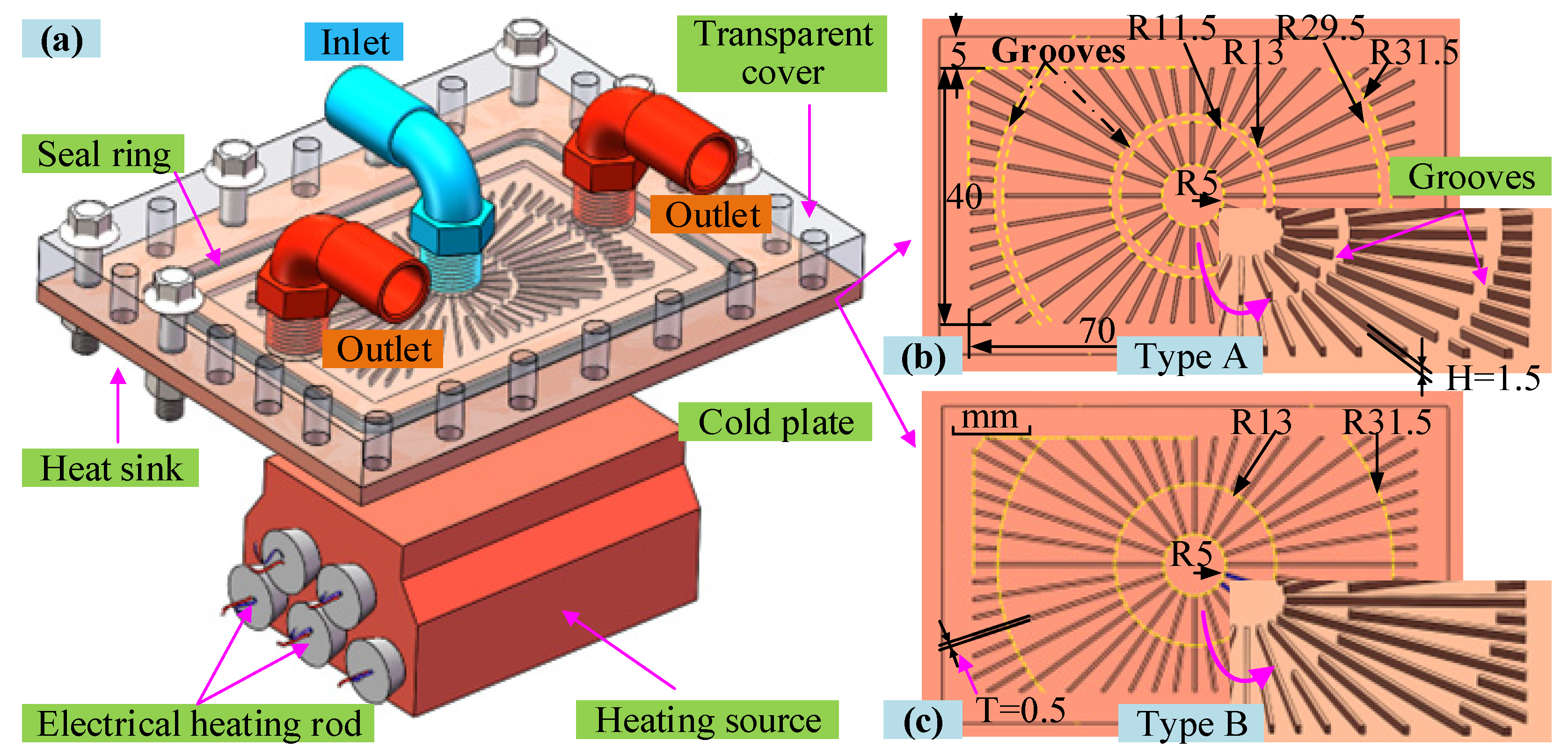

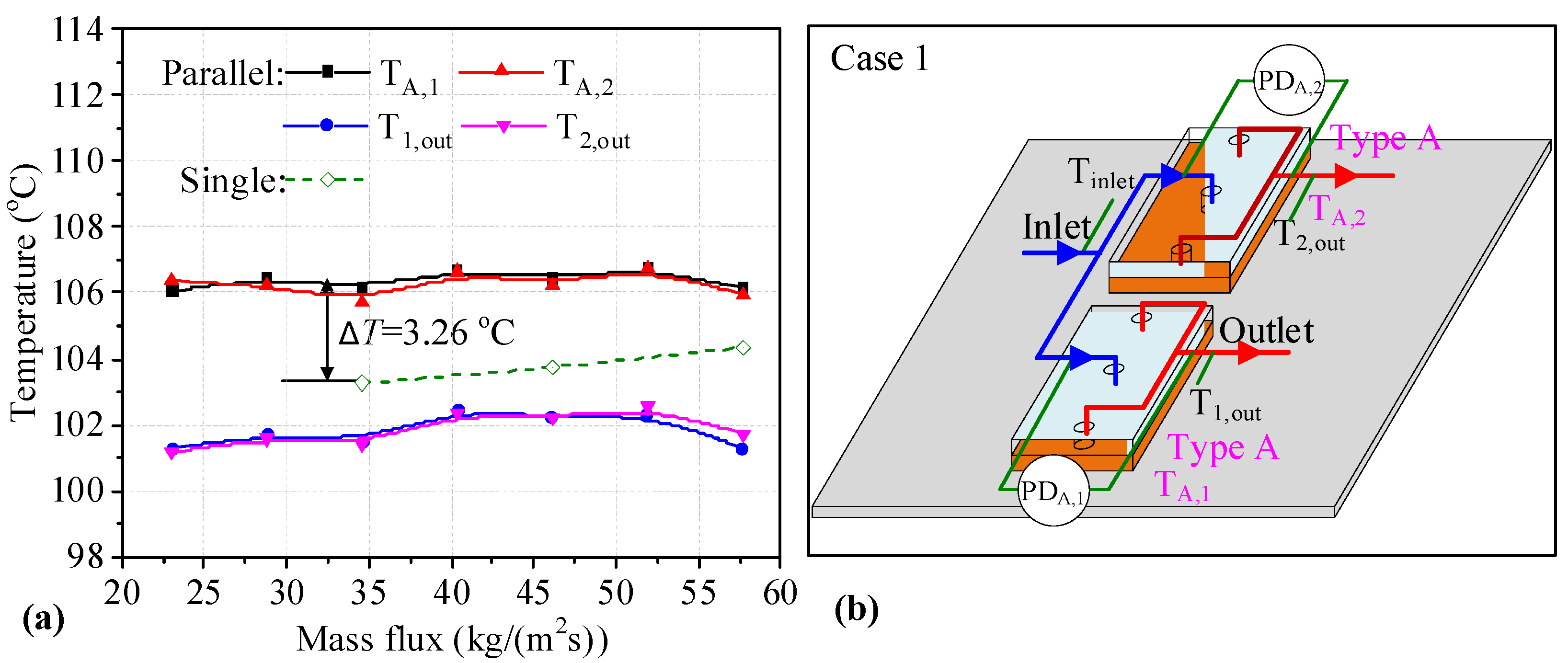
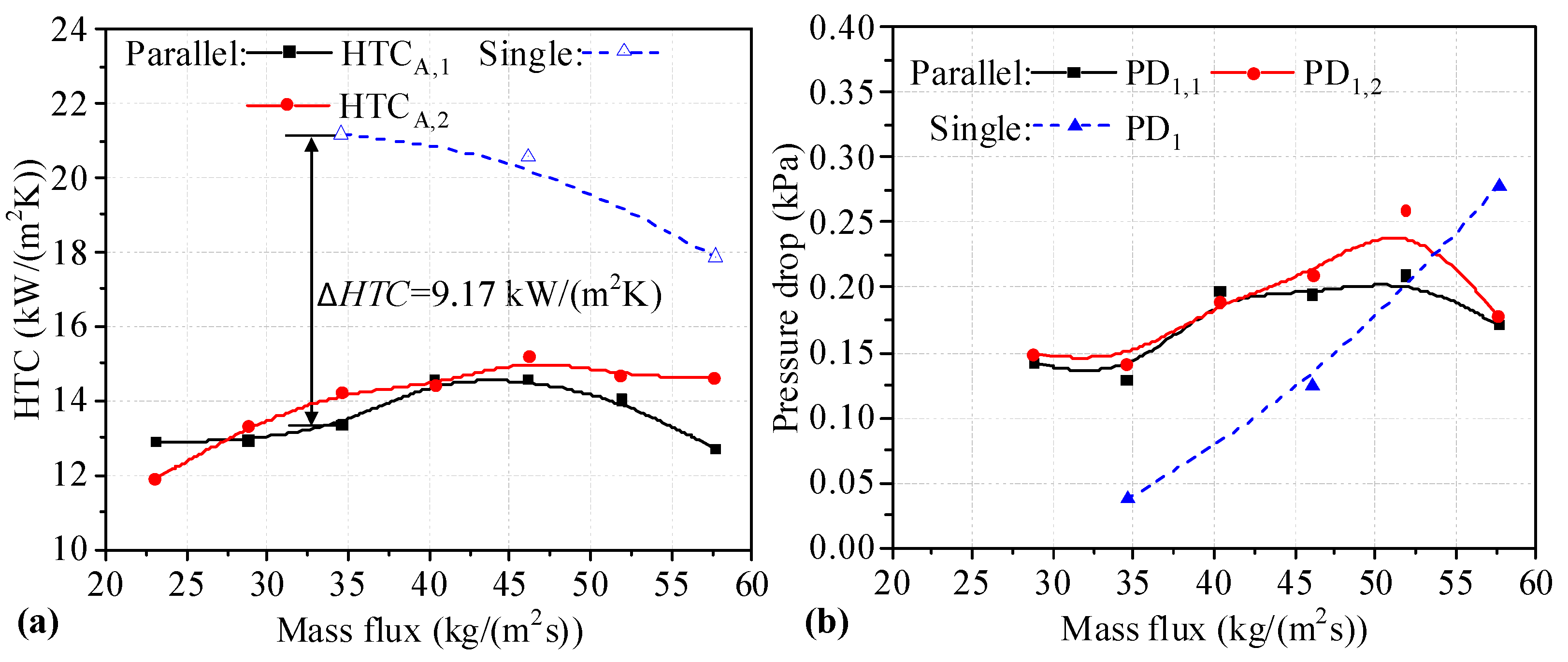

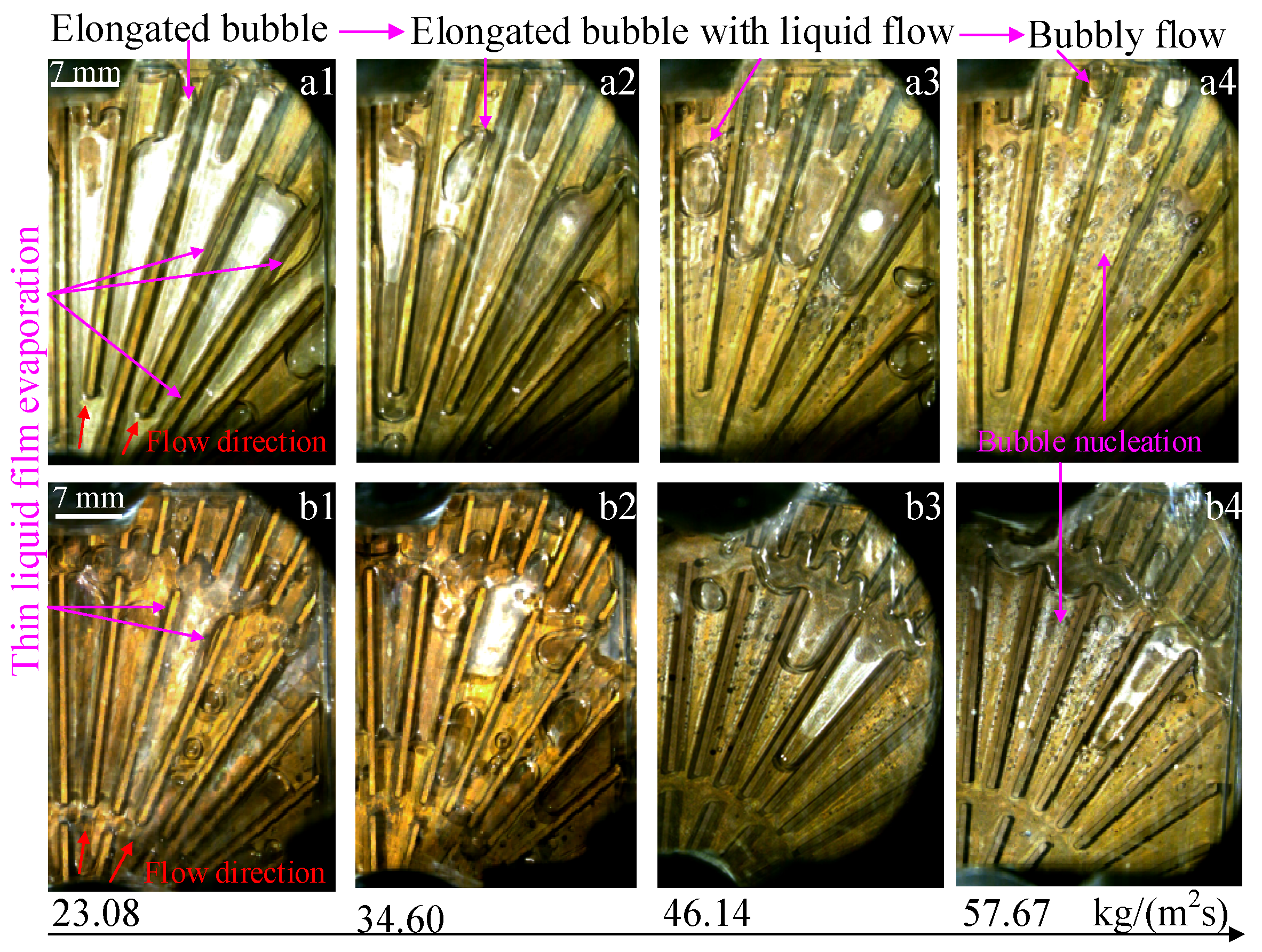
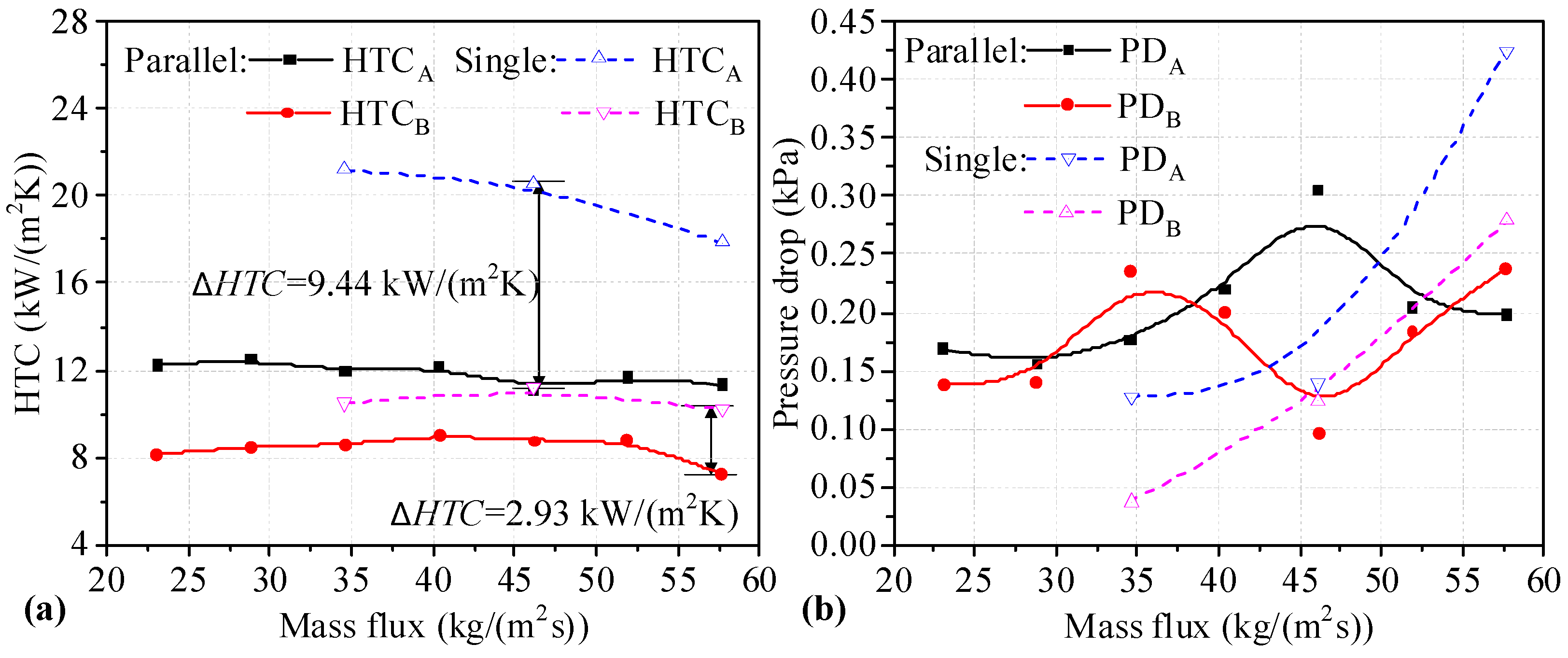

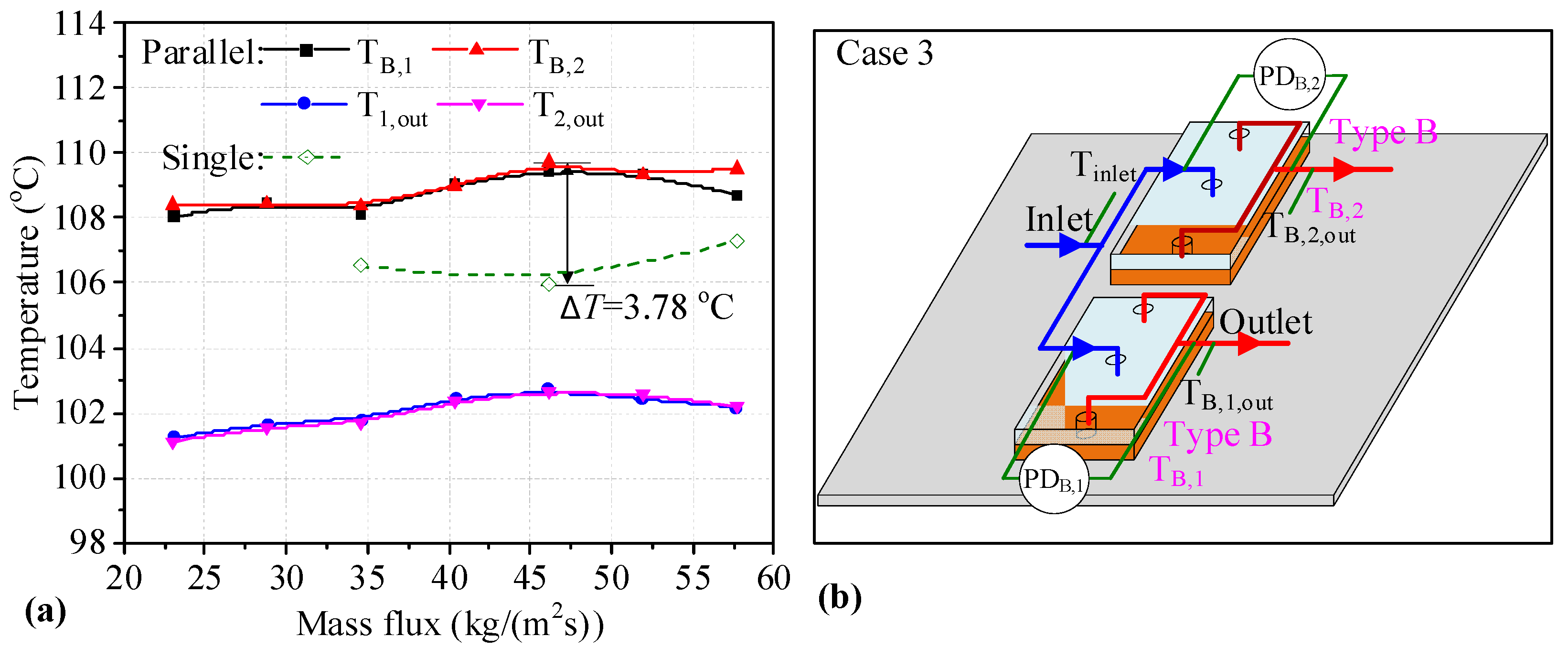


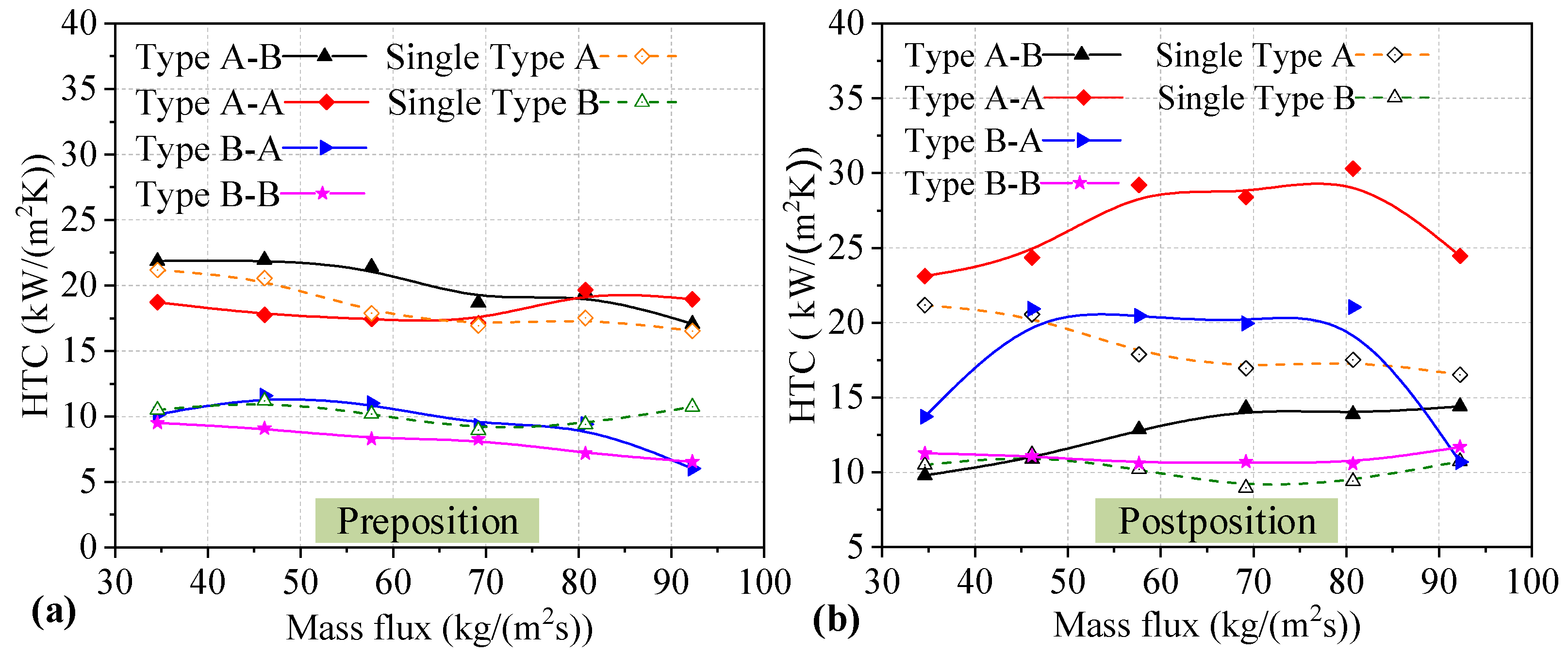
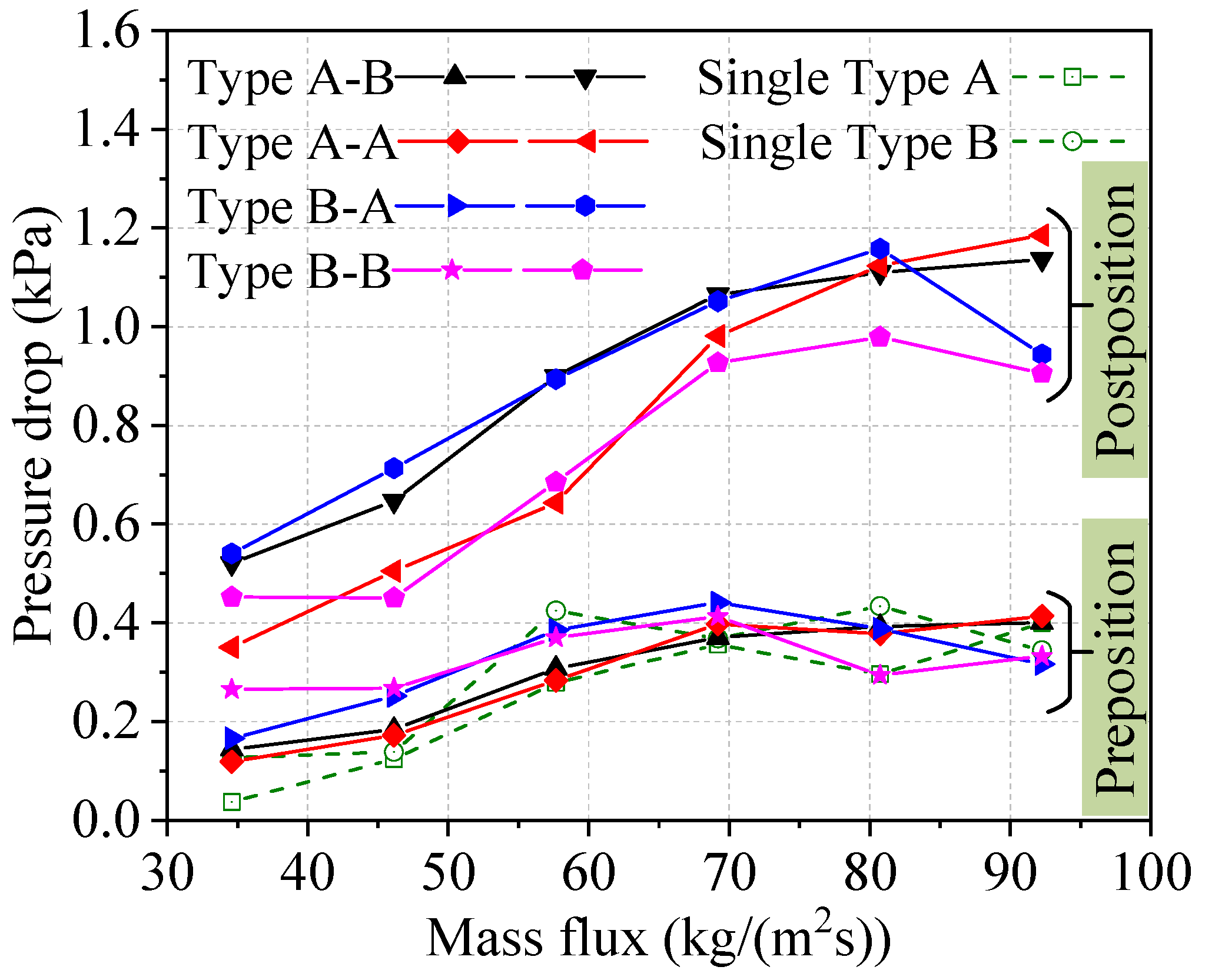
| Types | No. | Heat Sink Type | Volume Flow Rates and Mass Fluxes |
|---|---|---|---|
| In parallel | Case 1 | Type A–A | Main pipe volume flow rates (L/min): 0.16, 0.20, 0.24, 0.28, 0.32, 0.40 Corresponding mass fluxes (kg/(m2s)): 46.14, 57.67, 69.20, 80.74, 92.27, 103.81, 115.34 |
| Case 2 | Type A–B | ||
| Case 3 | Type B–B | ||
| In series | Case 4 | Type A–B | Volume flow rates (L/min): 0.12, 0.16, 0.20, 0.24, 0.28, 0.32 Corresponding mass fluxes (kg/(m2s)): 34.60, 46.14, 57.67, 69.20, 80.74, 92.27 |
| Case 5 | Type A–A | ||
| Case 6 | Type B–A | ||
| Case 7 | Type B–B |
| No. | Measured Parameters | Uncertainties |
|---|---|---|
| 1 | Volume flow rate (qv) | ±0.69% |
| 2 | Heating load (Q) | ±0.2% |
| 3 | Temperature (Tin, Tout, Tw) | ±0.2 K |
| 4 | Pressure drop (PD) | ±0.25% |
| 5 | Heat transfer coefficient (HTC) | ±7.68% |
| 6 | Mass flow (M) | ±0.96% |
| 7 | Dimension (A, H, D) | ±0.01 mm |
| No. | Correlations | a Mean Absolute Deviations | |
|---|---|---|---|
| Type A | Type B | ||
| 1 | Kandlikar | 24.32% | 6.00% |
| 2 | Fang and Zhou | 21.67% | 20.05% |
| 3 | Fang and Wu | 26.40% | 19.28% |
| No. | Parallel Connections | Right Heat Sink | Left Heat Sink | ||||
|---|---|---|---|---|---|---|---|
| Tw | HTC | PD | Tw | HTC | PD | ||
| Case 1 | Type A–Type A | 106.38 | 13.59 | 0.18 | 106.17 | 14.48 | 0.16 |
| Case 2 | Type A–Type B | 107.33 | 11.86 | 0.20 | 109.02 | 8.45 | 0.18 |
| Case 3 | Type B–Type B | 108.75 | 8.94 | 0.20 | 108.97 | 8.60 | 0.19 |
| Parallel Connections | ||||||||
| No. | Left Heat Sink | Heat Sink Types | Right Heat Sink | |||||
| Tw | HTC | PD | Left | Right | Tw | HTC | PD | |
| Case 1 | +2.43 | −5.81 | +0.02 | Type A–Type A | +2.46 | −6.32 | +0.03 | |
| Case 2 | +2.69 | −2.43 | −0.04 | Type A–Type B | +3.91 | −8.40 | +0.08 | |
| Case 3 | +2.61 | −2.12 | −0.03 | Type B–Type B | +2.18 | −1.50 | −0.05 | |
| Series Connections | ||||||||
| No. | Preposition Heat Sink | Heat Sink Types | Postposition Heat Sink | |||||
| Tw | HTC | PD | Pre. | Post. | Tw | HTC | PD | |
| Case 4 | +0.52 | +1.88 | +0.06 | Type A–Type B | +0.02 | +0.56 | +0.46 | |
| Case 5 | +0.51 | −1.90 | +0.04 | Type A–Type A | −0.15 | +5.68 | +0.35 | |
| Case 6 | +0.43 | +0.29 | +0.04 | Type B–Type A | +1.03 | −1.50 | +0.57 | |
| Case 7 | +1.66 | −1.67 | +0.07 | Type B–Type B | +0.15 | +0.36 | +0.30 | |
Disclaimer/Publisher’s Note: The statements, opinions and data contained in all publications are solely those of the individual author(s) and contributor(s) and not of MDPI and/or the editor(s). MDPI and/or the editor(s) disclaim responsibility for any injury to people or property resulting from any ideas, methods, instructions or products referred to in the content. |
© 2023 by the authors. Licensee MDPI, Basel, Switzerland. This article is an open access article distributed under the terms and conditions of the Creative Commons Attribution (CC BY) license (https://creativecommons.org/licenses/by/4.0/).
Share and Cite
Jiang, Z.; Song, M.; Shen, J.; Zhang, L.; Zhang, X.; Lin, S. Experimental Investigation on the Flow Boiling of Two Microchannel Heat Sinks Connected in Parallel and Series for Cooling of Multiple Heat Sources. Micromachines 2023, 14, 1580. https://doi.org/10.3390/mi14081580
Jiang Z, Song M, Shen J, Zhang L, Zhang X, Lin S. Experimental Investigation on the Flow Boiling of Two Microchannel Heat Sinks Connected in Parallel and Series for Cooling of Multiple Heat Sources. Micromachines. 2023; 14(8):1580. https://doi.org/10.3390/mi14081580
Chicago/Turabian StyleJiang, Zhengyong, Mengjie Song, Jun Shen, Long Zhang, Xuan Zhang, and Shenglun Lin. 2023. "Experimental Investigation on the Flow Boiling of Two Microchannel Heat Sinks Connected in Parallel and Series for Cooling of Multiple Heat Sources" Micromachines 14, no. 8: 1580. https://doi.org/10.3390/mi14081580
APA StyleJiang, Z., Song, M., Shen, J., Zhang, L., Zhang, X., & Lin, S. (2023). Experimental Investigation on the Flow Boiling of Two Microchannel Heat Sinks Connected in Parallel and Series for Cooling of Multiple Heat Sources. Micromachines, 14(8), 1580. https://doi.org/10.3390/mi14081580








